Comprehensive Report on Human Respiratory and Cardiac Systems
VerifiedAdded on 2020/06/04
|9
|2505
|163
Report
AI Summary
This report provides a detailed analysis of the human respiratory and cardiac systems. It begins by explaining the mechanisms regulating ventilation and pulse rates, discussing the roles of the nervous system, and the influence of sympathetic and parasympathetic responses. The report then explores the process of blood redistribution during exercise, highlighting the increase in blood flow, vasodilation, and the impact on various organs. It delves into the changes in artery structure associated with circulatory diseases, describing the layers of arteries and the impact of endothelial dysfunction and plaque formation. The report further examines the relationship between circulatory diseases and environmental factors like air pollution. Additionally, it discusses the changes in respiratory structure associated with respiratory diseases, such as asthma and bronchitis, and their connection to environmental factors, including harmful particles and climate change. The report concludes by summarizing the key findings and emphasizing the importance of understanding these complex systems.
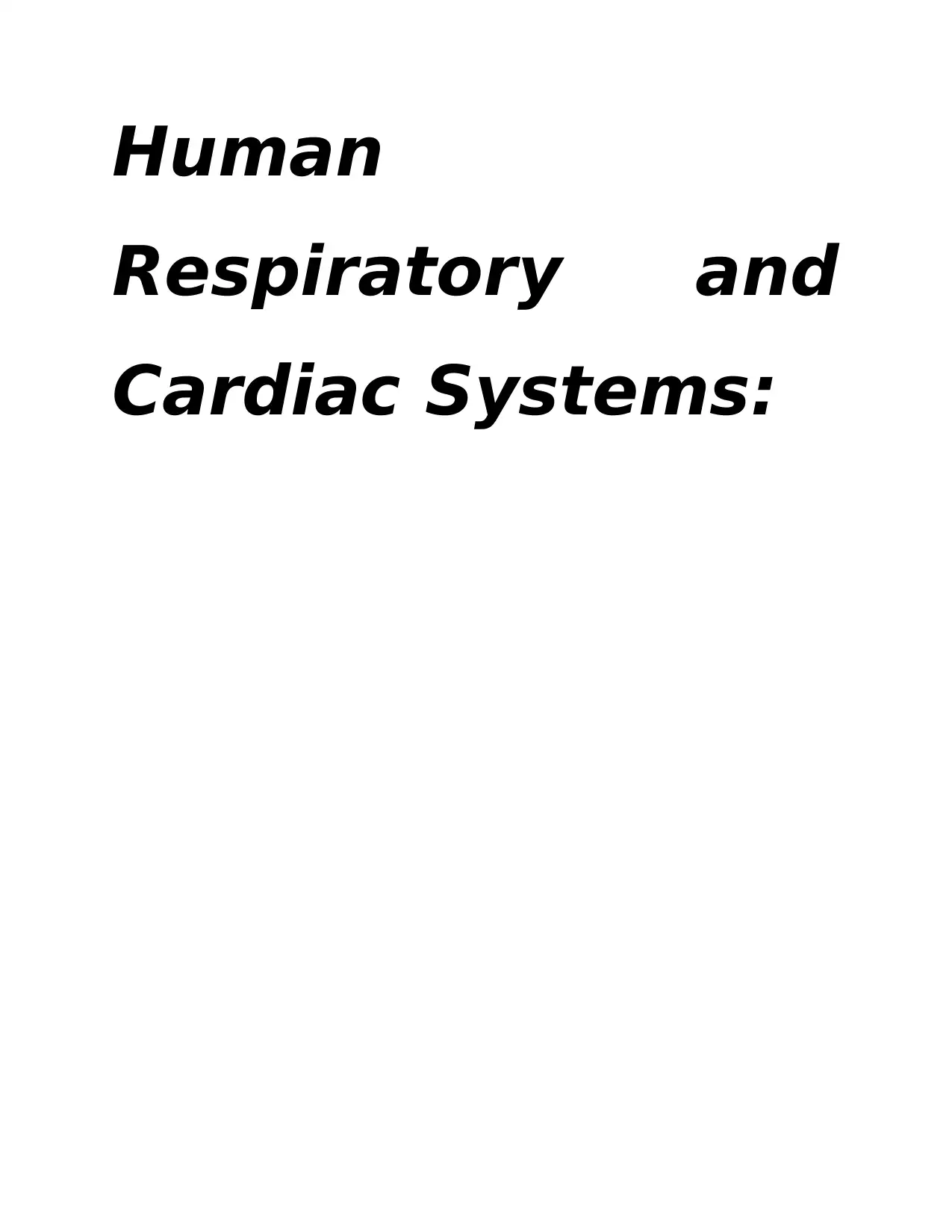
Human
Respiratory and
Cardiac Systems:
Respiratory and
Cardiac Systems:
Paraphrase This Document
Need a fresh take? Get an instant paraphrase of this document with our AI Paraphraser
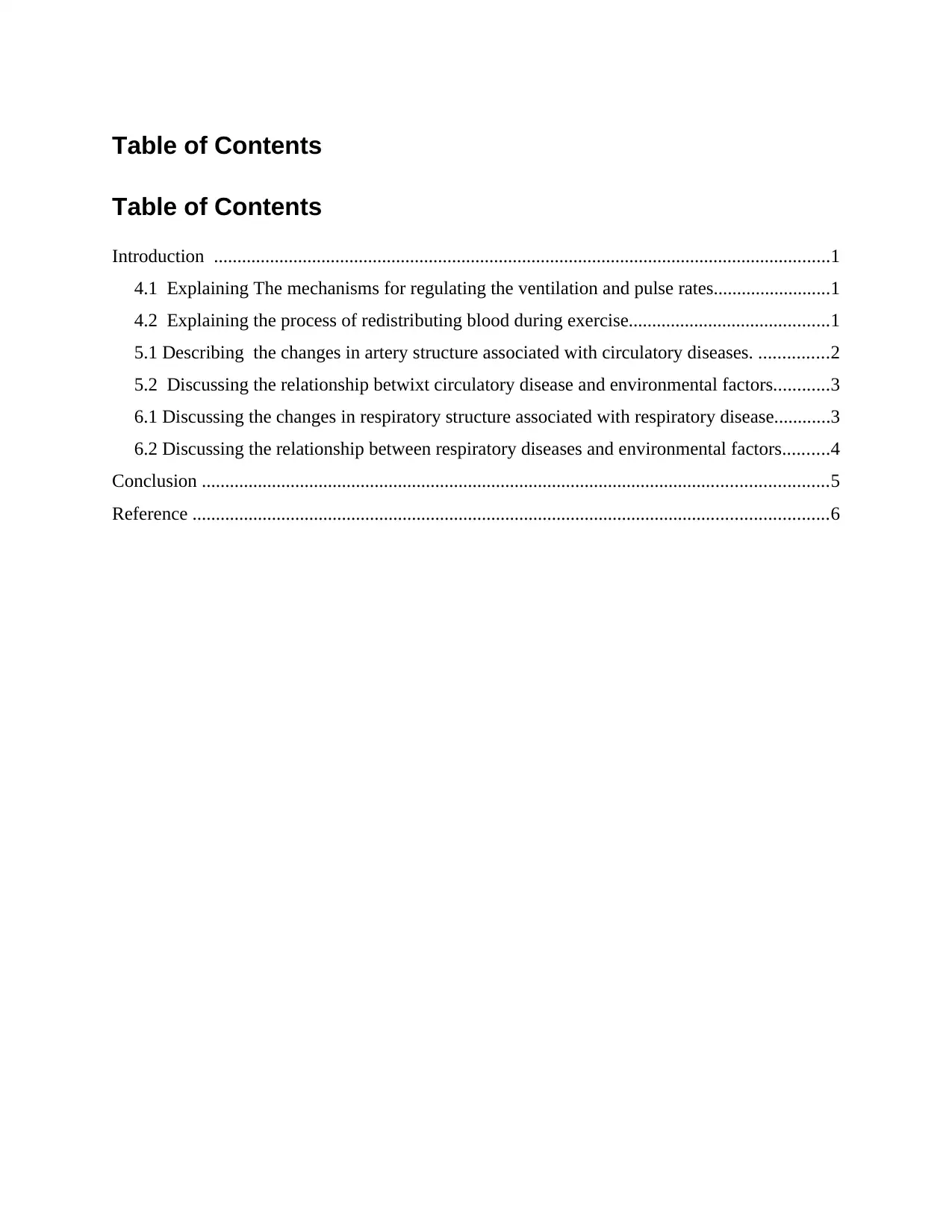
Table of Contents
Table of Contents
Introduction ....................................................................................................................................1
4.1 Explaining The mechanisms for regulating the ventilation and pulse rates.........................1
4.2 Explaining the process of redistributing blood during exercise...........................................1
5.1 Describing the changes in artery structure associated with circulatory diseases. ...............2
5.2 Discussing the relationship betwixt circulatory disease and environmental factors............3
6.1 Discussing the changes in respiratory structure associated with respiratory disease............3
6.2 Discussing the relationship between respiratory diseases and environmental factors..........4
Conclusion ......................................................................................................................................5
Reference ........................................................................................................................................6
Table of Contents
Introduction ....................................................................................................................................1
4.1 Explaining The mechanisms for regulating the ventilation and pulse rates.........................1
4.2 Explaining the process of redistributing blood during exercise...........................................1
5.1 Describing the changes in artery structure associated with circulatory diseases. ...............2
5.2 Discussing the relationship betwixt circulatory disease and environmental factors............3
6.1 Discussing the changes in respiratory structure associated with respiratory disease............3
6.2 Discussing the relationship between respiratory diseases and environmental factors..........4
Conclusion ......................................................................................................................................5
Reference ........................................................................................................................................6
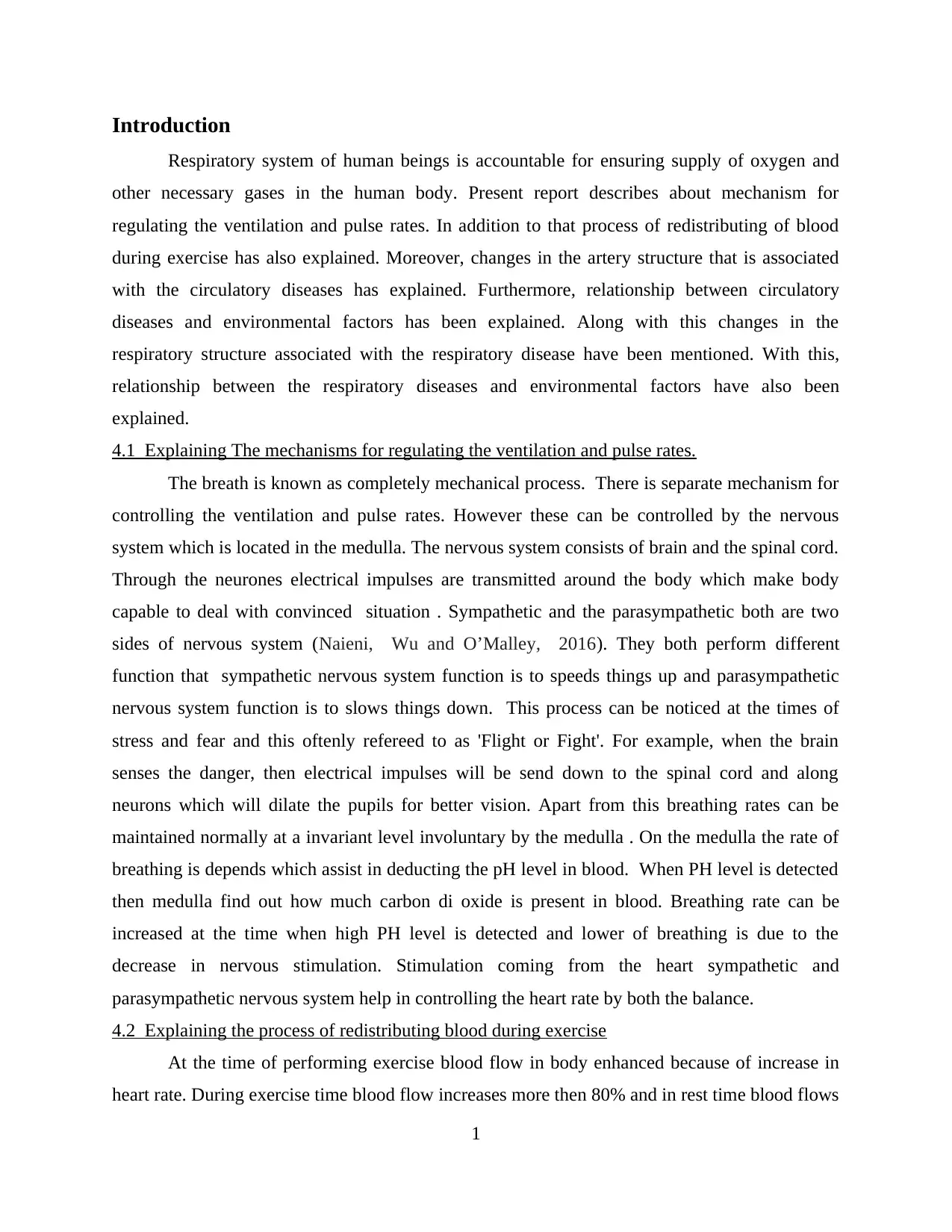
Introduction
Respiratory system of human beings is accountable for ensuring supply of oxygen and
other necessary gases in the human body. Present report describes about mechanism for
regulating the ventilation and pulse rates. In addition to that process of redistributing of blood
during exercise has also explained. Moreover, changes in the artery structure that is associated
with the circulatory diseases has explained. Furthermore, relationship between circulatory
diseases and environmental factors has been explained. Along with this changes in the
respiratory structure associated with the respiratory disease have been mentioned. With this,
relationship between the respiratory diseases and environmental factors have also been
explained.
4.1 Explaining The mechanisms for regulating the ventilation and pulse rates.
The breath is known as completely mechanical process. There is separate mechanism for
controlling the ventilation and pulse rates. However these can be controlled by the nervous
system which is located in the medulla. The nervous system consists of brain and the spinal cord.
Through the neurones electrical impulses are transmitted around the body which make body
capable to deal with convinced situation . Sympathetic and the parasympathetic both are two
sides of nervous system (Naieni, Wu and O’Malley, 2016). They both perform different
function that sympathetic nervous system function is to speeds things up and parasympathetic
nervous system function is to slows things down. This process can be noticed at the times of
stress and fear and this oftenly refereed to as 'Flight or Fight'. For example, when the brain
senses the danger, then electrical impulses will be send down to the spinal cord and along
neurons which will dilate the pupils for better vision. Apart from this breathing rates can be
maintained normally at a invariant level involuntary by the medulla . On the medulla the rate of
breathing is depends which assist in deducting the pH level in blood. When PH level is detected
then medulla find out how much carbon di oxide is present in blood. Breathing rate can be
increased at the time when high PH level is detected and lower of breathing is due to the
decrease in nervous stimulation. Stimulation coming from the heart sympathetic and
parasympathetic nervous system help in controlling the heart rate by both the balance.
4.2 Explaining the process of redistributing blood during exercise
At the time of performing exercise blood flow in body enhanced because of increase in
heart rate. During exercise time blood flow increases more then 80% and in rest time blood flows
1
Respiratory system of human beings is accountable for ensuring supply of oxygen and
other necessary gases in the human body. Present report describes about mechanism for
regulating the ventilation and pulse rates. In addition to that process of redistributing of blood
during exercise has also explained. Moreover, changes in the artery structure that is associated
with the circulatory diseases has explained. Furthermore, relationship between circulatory
diseases and environmental factors has been explained. Along with this changes in the
respiratory structure associated with the respiratory disease have been mentioned. With this,
relationship between the respiratory diseases and environmental factors have also been
explained.
4.1 Explaining The mechanisms for regulating the ventilation and pulse rates.
The breath is known as completely mechanical process. There is separate mechanism for
controlling the ventilation and pulse rates. However these can be controlled by the nervous
system which is located in the medulla. The nervous system consists of brain and the spinal cord.
Through the neurones electrical impulses are transmitted around the body which make body
capable to deal with convinced situation . Sympathetic and the parasympathetic both are two
sides of nervous system (Naieni, Wu and O’Malley, 2016). They both perform different
function that sympathetic nervous system function is to speeds things up and parasympathetic
nervous system function is to slows things down. This process can be noticed at the times of
stress and fear and this oftenly refereed to as 'Flight or Fight'. For example, when the brain
senses the danger, then electrical impulses will be send down to the spinal cord and along
neurons which will dilate the pupils for better vision. Apart from this breathing rates can be
maintained normally at a invariant level involuntary by the medulla . On the medulla the rate of
breathing is depends which assist in deducting the pH level in blood. When PH level is detected
then medulla find out how much carbon di oxide is present in blood. Breathing rate can be
increased at the time when high PH level is detected and lower of breathing is due to the
decrease in nervous stimulation. Stimulation coming from the heart sympathetic and
parasympathetic nervous system help in controlling the heart rate by both the balance.
4.2 Explaining the process of redistributing blood during exercise
At the time of performing exercise blood flow in body enhanced because of increase in
heart rate. During exercise time blood flow increases more then 80% and in rest time blood flows
1
⊘ This is a preview!⊘
Do you want full access?
Subscribe today to unlock all pages.

Trusted by 1+ million students worldwide

in all muscles upto 20%. Through the help of 3 things increase in blood flow can be identified
that is vasodilations of skeletal muscle arterioles, enhancing in cardiac output and
vasoconstriction of arterioles in the skin. Skeletal muscles pump blood to the heart at the time of
exercise. There is increase in end diastolic volume due to increase in the blood vessel return
which lead to cause the stroke volume to be enhanced. Further, at the time of exercise the muscle
activity enhanced which build up of substance and that afterwards induces the vasodilation of the
local arterioles. Body temperature also increases and connection tissue capillary artery dilate in
order to give out heat and reduce body temperature (Karch and Karch, 2016.). In exercise less
blood goes to other major organs excepted for the brain and heart and more blood flows to the
skin and other muscles. Blood vessel enlarge at the time of exercise in the working with the
capillaries blood started increasing. The function of nervous system is to prepare the body for
exercise by passing the hormones which signals the dilation of the blood vessels in the heart. All
the system act more efficiently after redistributing the muscles. If exercise is stopped suddenly
then it leads to leave us headed because of decrease of pumping action from the leg muscles to
the heart. On the other hand if suddenly started exercising this make use breathless and strain
muscle which is not ready for the exercise. Hence, it can be stated that during the exercise blood
flow increase and rise towards the skin. This enhancing in blood flow lead to more blood to go in
muscles and it provides energy to work harder and work effectively.
5.1 Describing the changes in artery structure associated with circulatory diseases.
Circulatory disease take place at the time when there is failure of special cell which line
the blood vessel. Those who fell to perform functions are knows as the endothelial cells and
epithelium lead to cause of the dysfunction of endothelial. In the starting of the hardening of the
arteries there is redness and resistant cell activation at the endothelial level, which lead to failure
of the endothelial and it leads to harm to the artery and there is created of plaque. There are three
layers in arteries which perform different functions. The outside layer is related with the
connective tissue and provide structure for supporting the under layer (Karch and Karch, 2016. ).
Then middle layer is very smooth muscles which allow to maintain blood pressure and also
control the blood flows. Further the inner layer is thin layer which provide protective and smooth
surface. The endothelial cells help in preventing toxic, blood borne substance from acquiring
inside to the fine-textured muscular tissue of the artery. For responding to the changes in blood
pressure this cells are very helpful and they release the substance into the smooth cells which
2
that is vasodilations of skeletal muscle arterioles, enhancing in cardiac output and
vasoconstriction of arterioles in the skin. Skeletal muscles pump blood to the heart at the time of
exercise. There is increase in end diastolic volume due to increase in the blood vessel return
which lead to cause the stroke volume to be enhanced. Further, at the time of exercise the muscle
activity enhanced which build up of substance and that afterwards induces the vasodilation of the
local arterioles. Body temperature also increases and connection tissue capillary artery dilate in
order to give out heat and reduce body temperature (Karch and Karch, 2016.). In exercise less
blood goes to other major organs excepted for the brain and heart and more blood flows to the
skin and other muscles. Blood vessel enlarge at the time of exercise in the working with the
capillaries blood started increasing. The function of nervous system is to prepare the body for
exercise by passing the hormones which signals the dilation of the blood vessels in the heart. All
the system act more efficiently after redistributing the muscles. If exercise is stopped suddenly
then it leads to leave us headed because of decrease of pumping action from the leg muscles to
the heart. On the other hand if suddenly started exercising this make use breathless and strain
muscle which is not ready for the exercise. Hence, it can be stated that during the exercise blood
flow increase and rise towards the skin. This enhancing in blood flow lead to more blood to go in
muscles and it provides energy to work harder and work effectively.
5.1 Describing the changes in artery structure associated with circulatory diseases.
Circulatory disease take place at the time when there is failure of special cell which line
the blood vessel. Those who fell to perform functions are knows as the endothelial cells and
epithelium lead to cause of the dysfunction of endothelial. In the starting of the hardening of the
arteries there is redness and resistant cell activation at the endothelial level, which lead to failure
of the endothelial and it leads to harm to the artery and there is created of plaque. There are three
layers in arteries which perform different functions. The outside layer is related with the
connective tissue and provide structure for supporting the under layer (Karch and Karch, 2016. ).
Then middle layer is very smooth muscles which allow to maintain blood pressure and also
control the blood flows. Further the inner layer is thin layer which provide protective and smooth
surface. The endothelial cells help in preventing toxic, blood borne substance from acquiring
inside to the fine-textured muscular tissue of the artery. For responding to the changes in blood
pressure this cells are very helpful and they release the substance into the smooth cells which
2
Paraphrase This Document
Need a fresh take? Get an instant paraphrase of this document with our AI Paraphraser
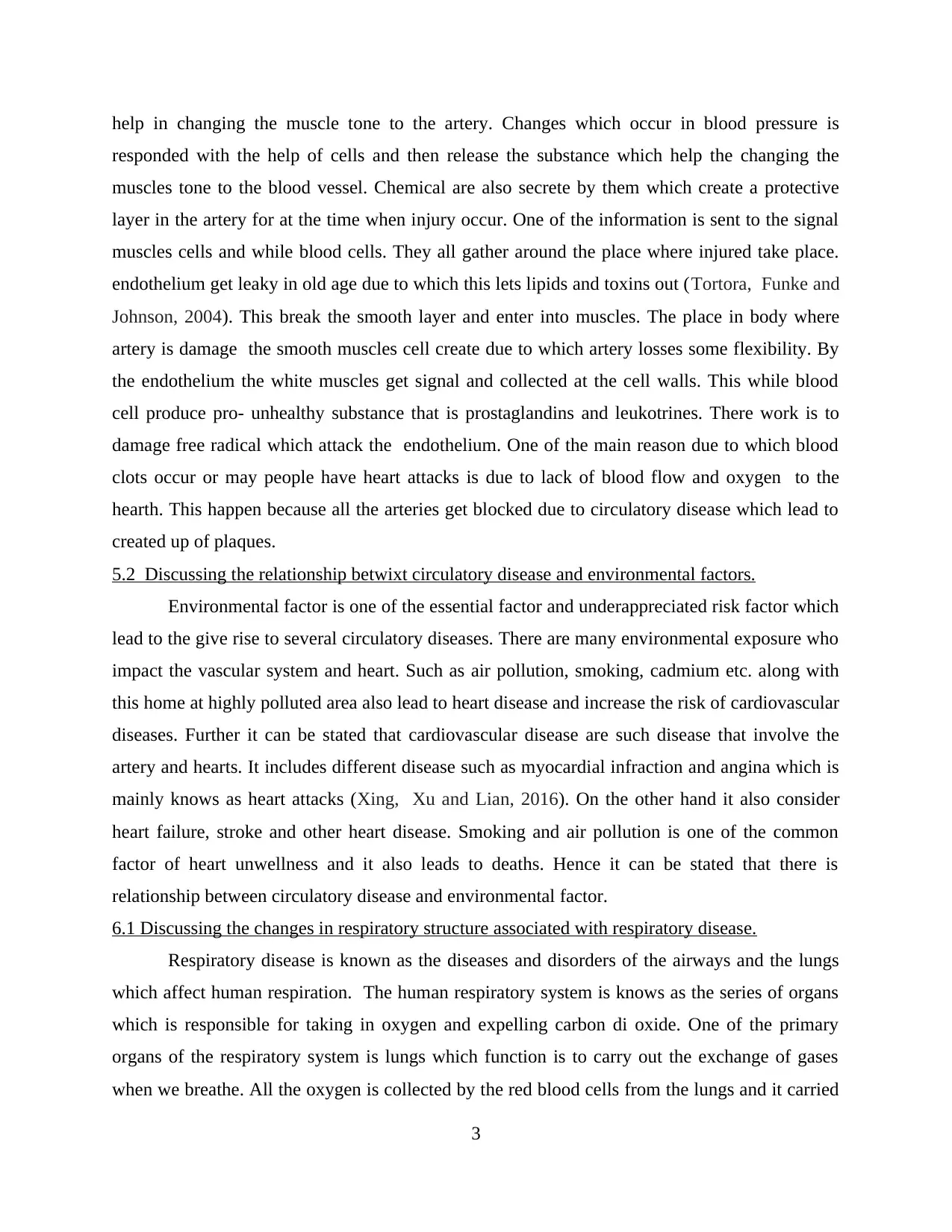
help in changing the muscle tone to the artery. Changes which occur in blood pressure is
responded with the help of cells and then release the substance which help the changing the
muscles tone to the blood vessel. Chemical are also secrete by them which create a protective
layer in the artery for at the time when injury occur. One of the information is sent to the signal
muscles cells and while blood cells. They all gather around the place where injured take place.
endothelium get leaky in old age due to which this lets lipids and toxins out (Tortora, Funke and
Johnson, 2004). This break the smooth layer and enter into muscles. The place in body where
artery is damage the smooth muscles cell create due to which artery losses some flexibility. By
the endothelium the white muscles get signal and collected at the cell walls. This while blood
cell produce pro- unhealthy substance that is prostaglandins and leukotrines. There work is to
damage free radical which attack the endothelium. One of the main reason due to which blood
clots occur or may people have heart attacks is due to lack of blood flow and oxygen to the
hearth. This happen because all the arteries get blocked due to circulatory disease which lead to
created up of plaques.
5.2 Discussing the relationship betwixt circulatory disease and environmental factors.
Environmental factor is one of the essential factor and underappreciated risk factor which
lead to the give rise to several circulatory diseases. There are many environmental exposure who
impact the vascular system and heart. Such as air pollution, smoking, cadmium etc. along with
this home at highly polluted area also lead to heart disease and increase the risk of cardiovascular
diseases. Further it can be stated that cardiovascular disease are such disease that involve the
artery and hearts. It includes different disease such as myocardial infraction and angina which is
mainly knows as heart attacks (Xing, Xu and Lian, 2016). On the other hand it also consider
heart failure, stroke and other heart disease. Smoking and air pollution is one of the common
factor of heart unwellness and it also leads to deaths. Hence it can be stated that there is
relationship between circulatory disease and environmental factor.
6.1 Discussing the changes in respiratory structure associated with respiratory disease.
Respiratory disease is known as the diseases and disorders of the airways and the lungs
which affect human respiration. The human respiratory system is knows as the series of organs
which is responsible for taking in oxygen and expelling carbon di oxide. One of the primary
organs of the respiratory system is lungs which function is to carry out the exchange of gases
when we breathe. All the oxygen is collected by the red blood cells from the lungs and it carried
3
responded with the help of cells and then release the substance which help the changing the
muscles tone to the blood vessel. Chemical are also secrete by them which create a protective
layer in the artery for at the time when injury occur. One of the information is sent to the signal
muscles cells and while blood cells. They all gather around the place where injured take place.
endothelium get leaky in old age due to which this lets lipids and toxins out (Tortora, Funke and
Johnson, 2004). This break the smooth layer and enter into muscles. The place in body where
artery is damage the smooth muscles cell create due to which artery losses some flexibility. By
the endothelium the white muscles get signal and collected at the cell walls. This while blood
cell produce pro- unhealthy substance that is prostaglandins and leukotrines. There work is to
damage free radical which attack the endothelium. One of the main reason due to which blood
clots occur or may people have heart attacks is due to lack of blood flow and oxygen to the
hearth. This happen because all the arteries get blocked due to circulatory disease which lead to
created up of plaques.
5.2 Discussing the relationship betwixt circulatory disease and environmental factors.
Environmental factor is one of the essential factor and underappreciated risk factor which
lead to the give rise to several circulatory diseases. There are many environmental exposure who
impact the vascular system and heart. Such as air pollution, smoking, cadmium etc. along with
this home at highly polluted area also lead to heart disease and increase the risk of cardiovascular
diseases. Further it can be stated that cardiovascular disease are such disease that involve the
artery and hearts. It includes different disease such as myocardial infraction and angina which is
mainly knows as heart attacks (Xing, Xu and Lian, 2016). On the other hand it also consider
heart failure, stroke and other heart disease. Smoking and air pollution is one of the common
factor of heart unwellness and it also leads to deaths. Hence it can be stated that there is
relationship between circulatory disease and environmental factor.
6.1 Discussing the changes in respiratory structure associated with respiratory disease.
Respiratory disease is known as the diseases and disorders of the airways and the lungs
which affect human respiration. The human respiratory system is knows as the series of organs
which is responsible for taking in oxygen and expelling carbon di oxide. One of the primary
organs of the respiratory system is lungs which function is to carry out the exchange of gases
when we breathe. All the oxygen is collected by the red blood cells from the lungs and it carried
3
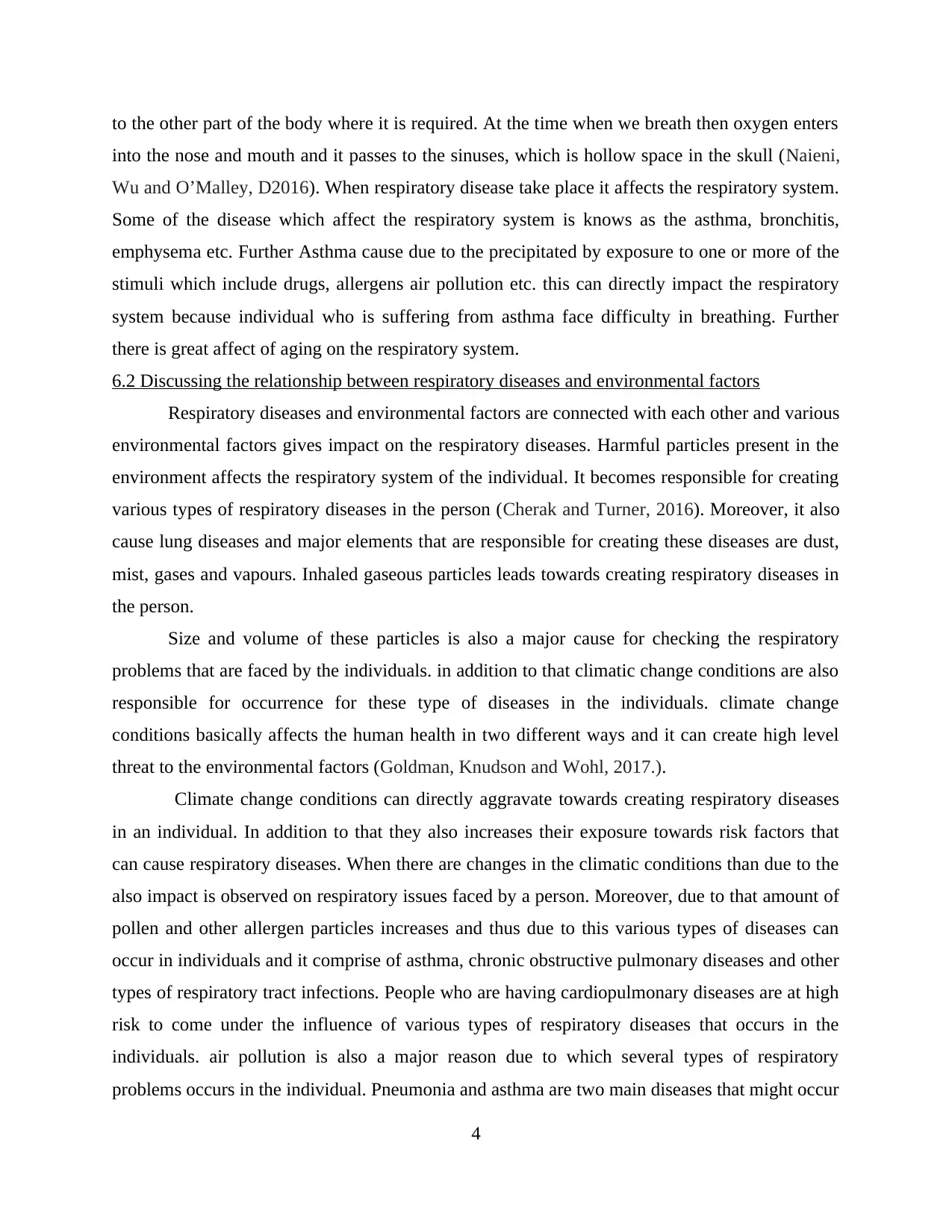
to the other part of the body where it is required. At the time when we breath then oxygen enters
into the nose and mouth and it passes to the sinuses, which is hollow space in the skull (Naieni,
Wu and O’Malley, D2016). When respiratory disease take place it affects the respiratory system.
Some of the disease which affect the respiratory system is knows as the asthma, bronchitis,
emphysema etc. Further Asthma cause due to the precipitated by exposure to one or more of the
stimuli which include drugs, allergens air pollution etc. this can directly impact the respiratory
system because individual who is suffering from asthma face difficulty in breathing. Further
there is great affect of aging on the respiratory system.
6.2 Discussing the relationship between respiratory diseases and environmental factors
Respiratory diseases and environmental factors are connected with each other and various
environmental factors gives impact on the respiratory diseases. Harmful particles present in the
environment affects the respiratory system of the individual. It becomes responsible for creating
various types of respiratory diseases in the person (Cherak and Turner, 2016). Moreover, it also
cause lung diseases and major elements that are responsible for creating these diseases are dust,
mist, gases and vapours. Inhaled gaseous particles leads towards creating respiratory diseases in
the person.
Size and volume of these particles is also a major cause for checking the respiratory
problems that are faced by the individuals. in addition to that climatic change conditions are also
responsible for occurrence for these type of diseases in the individuals. climate change
conditions basically affects the human health in two different ways and it can create high level
threat to the environmental factors (Goldman, Knudson and Wohl, 2017.).
Climate change conditions can directly aggravate towards creating respiratory diseases
in an individual. In addition to that they also increases their exposure towards risk factors that
can cause respiratory diseases. When there are changes in the climatic conditions than due to the
also impact is observed on respiratory issues faced by a person. Moreover, due to that amount of
pollen and other allergen particles increases and thus due to this various types of diseases can
occur in individuals and it comprise of asthma, chronic obstructive pulmonary diseases and other
types of respiratory tract infections. People who are having cardiopulmonary diseases are at high
risk to come under the influence of various types of respiratory diseases that occurs in the
individuals. air pollution is also a major reason due to which several types of respiratory
problems occurs in the individual. Pneumonia and asthma are two main diseases that might occur
4
into the nose and mouth and it passes to the sinuses, which is hollow space in the skull (Naieni,
Wu and O’Malley, D2016). When respiratory disease take place it affects the respiratory system.
Some of the disease which affect the respiratory system is knows as the asthma, bronchitis,
emphysema etc. Further Asthma cause due to the precipitated by exposure to one or more of the
stimuli which include drugs, allergens air pollution etc. this can directly impact the respiratory
system because individual who is suffering from asthma face difficulty in breathing. Further
there is great affect of aging on the respiratory system.
6.2 Discussing the relationship between respiratory diseases and environmental factors
Respiratory diseases and environmental factors are connected with each other and various
environmental factors gives impact on the respiratory diseases. Harmful particles present in the
environment affects the respiratory system of the individual. It becomes responsible for creating
various types of respiratory diseases in the person (Cherak and Turner, 2016). Moreover, it also
cause lung diseases and major elements that are responsible for creating these diseases are dust,
mist, gases and vapours. Inhaled gaseous particles leads towards creating respiratory diseases in
the person.
Size and volume of these particles is also a major cause for checking the respiratory
problems that are faced by the individuals. in addition to that climatic change conditions are also
responsible for occurrence for these type of diseases in the individuals. climate change
conditions basically affects the human health in two different ways and it can create high level
threat to the environmental factors (Goldman, Knudson and Wohl, 2017.).
Climate change conditions can directly aggravate towards creating respiratory diseases
in an individual. In addition to that they also increases their exposure towards risk factors that
can cause respiratory diseases. When there are changes in the climatic conditions than due to the
also impact is observed on respiratory issues faced by a person. Moreover, due to that amount of
pollen and other allergen particles increases and thus due to this various types of diseases can
occur in individuals and it comprise of asthma, chronic obstructive pulmonary diseases and other
types of respiratory tract infections. People who are having cardiopulmonary diseases are at high
risk to come under the influence of various types of respiratory diseases that occurs in the
individuals. air pollution is also a major reason due to which several types of respiratory
problems occurs in the individual. Pneumonia and asthma are two main diseases that might occur
4
⊘ This is a preview!⊘
Do you want full access?
Subscribe today to unlock all pages.

Trusted by 1+ million students worldwide
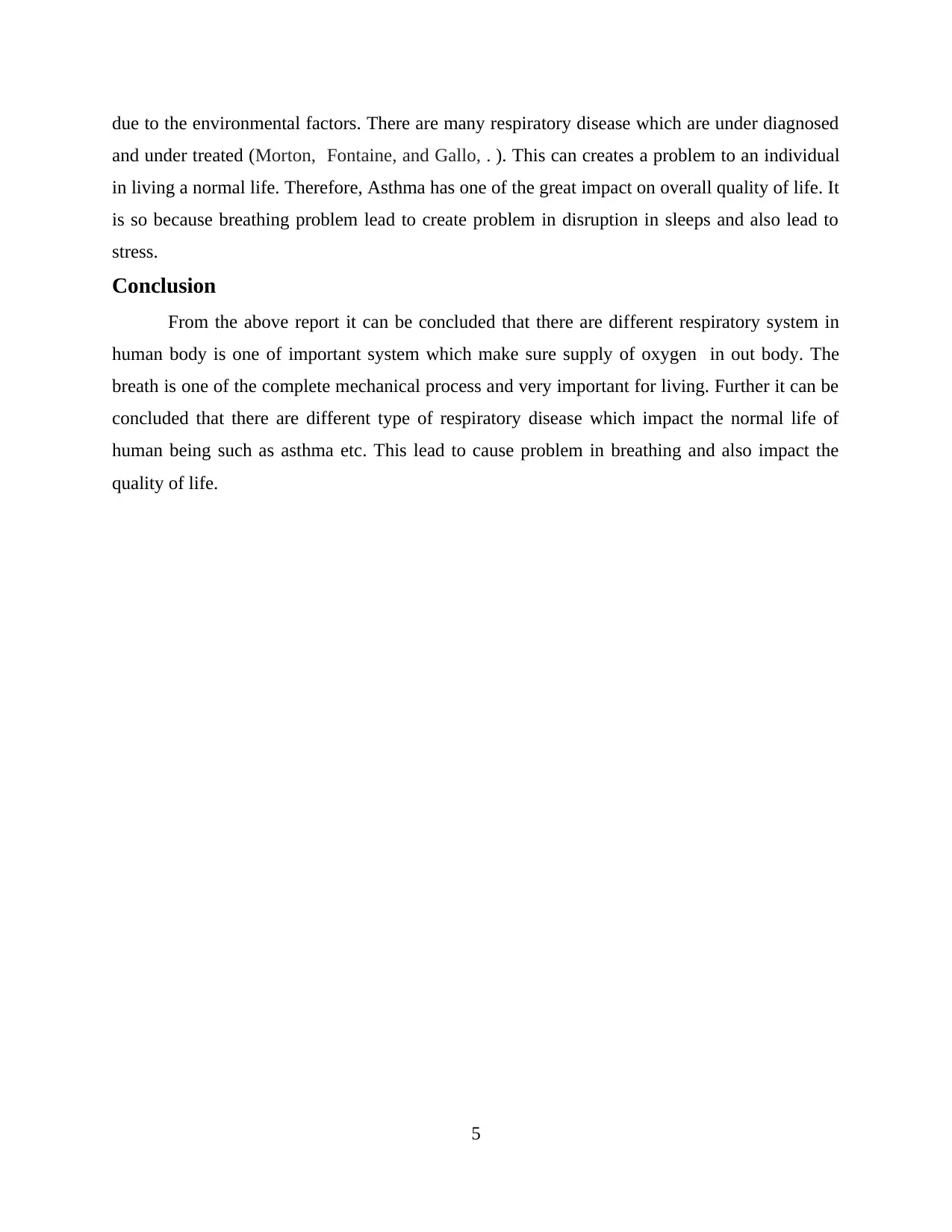
due to the environmental factors. There are many respiratory disease which are under diagnosed
and under treated (Morton, Fontaine, and Gallo, . ). This can creates a problem to an individual
in living a normal life. Therefore, Asthma has one of the great impact on overall quality of life. It
is so because breathing problem lead to create problem in disruption in sleeps and also lead to
stress.
Conclusion
From the above report it can be concluded that there are different respiratory system in
human body is one of important system which make sure supply of oxygen in out body. The
breath is one of the complete mechanical process and very important for living. Further it can be
concluded that there are different type of respiratory disease which impact the normal life of
human being such as asthma etc. This lead to cause problem in breathing and also impact the
quality of life.
5
and under treated (Morton, Fontaine, and Gallo, . ). This can creates a problem to an individual
in living a normal life. Therefore, Asthma has one of the great impact on overall quality of life. It
is so because breathing problem lead to create problem in disruption in sleeps and also lead to
stress.
Conclusion
From the above report it can be concluded that there are different respiratory system in
human body is one of important system which make sure supply of oxygen in out body. The
breath is one of the complete mechanical process and very important for living. Further it can be
concluded that there are different type of respiratory disease which impact the normal life of
human being such as asthma etc. This lead to cause problem in breathing and also impact the
quality of life.
5
Paraphrase This Document
Need a fresh take? Get an instant paraphrase of this document with our AI Paraphraser
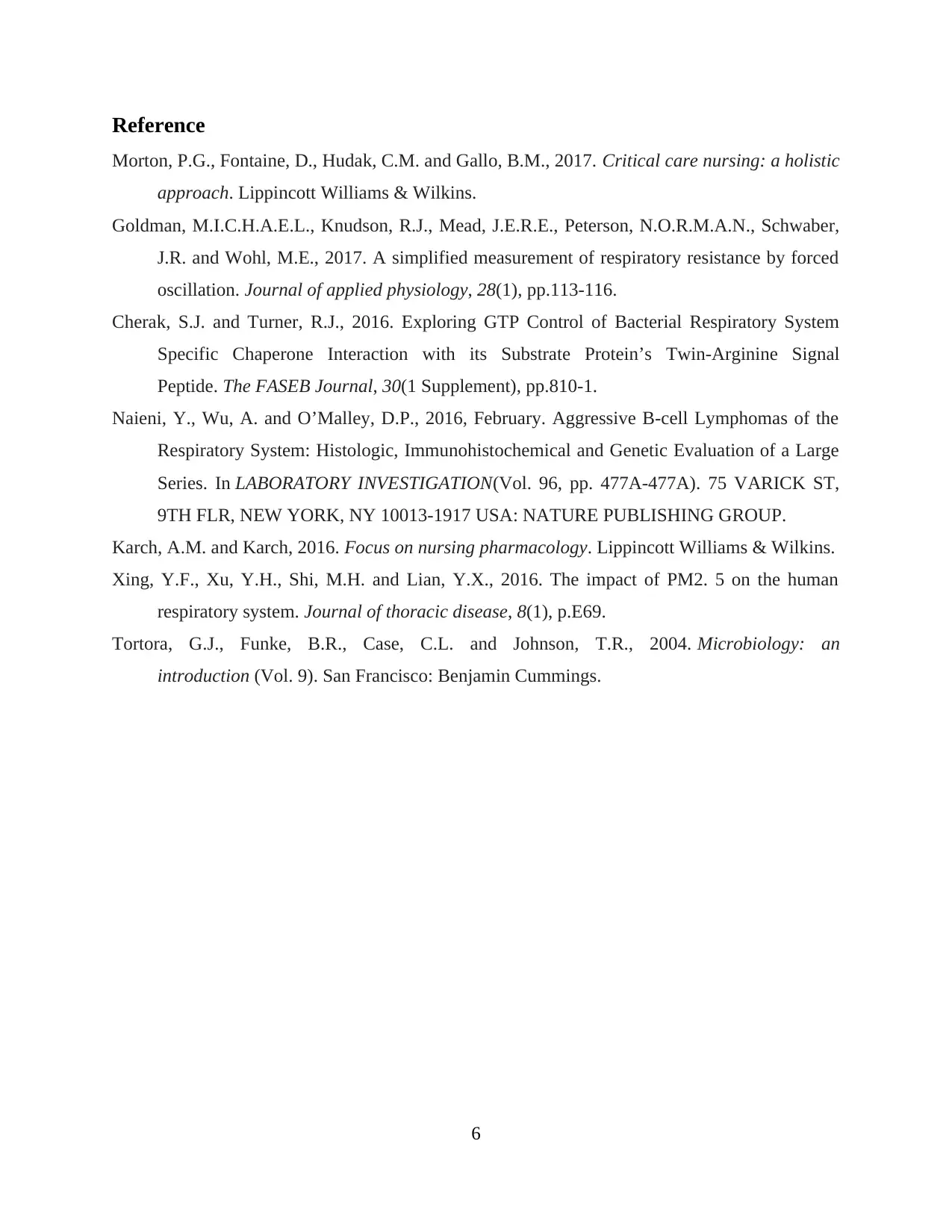
Reference
Morton, P.G., Fontaine, D., Hudak, C.M. and Gallo, B.M., 2017. Critical care nursing: a holistic
approach. Lippincott Williams & Wilkins.
Goldman, M.I.C.H.A.E.L., Knudson, R.J., Mead, J.E.R.E., Peterson, N.O.R.M.A.N., Schwaber,
J.R. and Wohl, M.E., 2017. A simplified measurement of respiratory resistance by forced
oscillation. Journal of applied physiology, 28(1), pp.113-116.
Cherak, S.J. and Turner, R.J., 2016. Exploring GTP Control of Bacterial Respiratory System
Specific Chaperone Interaction with its Substrate Protein’s Twin-Arginine Signal
Peptide. The FASEB Journal, 30(1 Supplement), pp.810-1.
Naieni, Y., Wu, A. and O’Malley, D.P., 2016, February. Aggressive B-cell Lymphomas of the
Respiratory System: Histologic, Immunohistochemical and Genetic Evaluation of a Large
Series. In LABORATORY INVESTIGATION(Vol. 96, pp. 477A-477A). 75 VARICK ST,
9TH FLR, NEW YORK, NY 10013-1917 USA: NATURE PUBLISHING GROUP.
Karch, A.M. and Karch, 2016. Focus on nursing pharmacology. Lippincott Williams & Wilkins.
Xing, Y.F., Xu, Y.H., Shi, M.H. and Lian, Y.X., 2016. The impact of PM2. 5 on the human
respiratory system. Journal of thoracic disease, 8(1), p.E69.
Tortora, G.J., Funke, B.R., Case, C.L. and Johnson, T.R., 2004. Microbiology: an
introduction (Vol. 9). San Francisco: Benjamin Cummings.
6
Morton, P.G., Fontaine, D., Hudak, C.M. and Gallo, B.M., 2017. Critical care nursing: a holistic
approach. Lippincott Williams & Wilkins.
Goldman, M.I.C.H.A.E.L., Knudson, R.J., Mead, J.E.R.E., Peterson, N.O.R.M.A.N., Schwaber,
J.R. and Wohl, M.E., 2017. A simplified measurement of respiratory resistance by forced
oscillation. Journal of applied physiology, 28(1), pp.113-116.
Cherak, S.J. and Turner, R.J., 2016. Exploring GTP Control of Bacterial Respiratory System
Specific Chaperone Interaction with its Substrate Protein’s Twin-Arginine Signal
Peptide. The FASEB Journal, 30(1 Supplement), pp.810-1.
Naieni, Y., Wu, A. and O’Malley, D.P., 2016, February. Aggressive B-cell Lymphomas of the
Respiratory System: Histologic, Immunohistochemical and Genetic Evaluation of a Large
Series. In LABORATORY INVESTIGATION(Vol. 96, pp. 477A-477A). 75 VARICK ST,
9TH FLR, NEW YORK, NY 10013-1917 USA: NATURE PUBLISHING GROUP.
Karch, A.M. and Karch, 2016. Focus on nursing pharmacology. Lippincott Williams & Wilkins.
Xing, Y.F., Xu, Y.H., Shi, M.H. and Lian, Y.X., 2016. The impact of PM2. 5 on the human
respiratory system. Journal of thoracic disease, 8(1), p.E69.
Tortora, G.J., Funke, B.R., Case, C.L. and Johnson, T.R., 2004. Microbiology: an
introduction (Vol. 9). San Francisco: Benjamin Cummings.
6

7
⊘ This is a preview!⊘
Do you want full access?
Subscribe today to unlock all pages.

Trusted by 1+ million students worldwide
1 out of 9
Related Documents
Your All-in-One AI-Powered Toolkit for Academic Success.
+13062052269
info@desklib.com
Available 24*7 on WhatsApp / Email
![[object Object]](/_next/static/media/star-bottom.7253800d.svg)
Unlock your academic potential
Copyright © 2020–2025 A2Z Services. All Rights Reserved. Developed and managed by ZUCOL.





